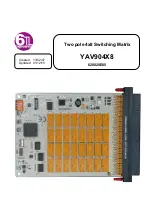
Understanding the VP-727xl
21
8 Understanding the VP-727xl
This section describes the:
UNIVERSAL inputs, see section 8.1
PREVIEW/PROGRAM outputs, see section 8.2
Switching/Scaling of an input, see section 8.3
PIP feature, see section 8.4
Panel Lock, see section 8.5
8.1 Understanding the UNIVERSAL Inputs
The
VP-727xl
has 8 sets of inputs
1
; each set can be programmed to operate as
composite video, s-Video, component video, RGB/YUV, RGBS, RGsB, or
RGBHV. INPUT 1 and INPUT 2 can also accept HDMI inputs.
The
VP-727xl
is a
universal
presentation matrix switcher / scaler: you
choose what type of source to connect to each input. You can connect
different video types or the same or similar video types. See the examples in
Figure 3 and Figure 4 in section 6.
8.2 Understanding the PREVIEW/PROGRAM Outputs
The
VP-727xl
has two outputs: a PREVIEW output, and a PROGRAM
output. Each of these outputs functions independently and has HDMI
connectors and VGA connectors, as well as sets of 5 BNC connectors
2
: R/P
R
,
G/Y, B/P
B
, H
S
, and V
S
.
The HDMI signal is usually HDCP protected. It is therefore recommended to use a
display that is HDCP compliant, otherwise the HDMI output will not appear on the
screen
Using the
PREVIEW
output, you can:
See how the scaled output will look before displaying live during a presentation.
As the example in Figure 9 illustrates, after seeing how the RGB source looks
when scaled to HDMI, it can be interchanged with the YUV source,
seamlessly, using an elaborate (in this case chessboard) transition effect
Harmonize transition to the PROGRAM output after determining the look
and feel when in the PREVIEW output
Use the OSD menu to make adjustments and choose the settings
Set the transition, choosing one of any eight special effects
1 Each set consists of 5 BNC connectors: R/Pr, G/Y/CV, B/Pb/C, Hs/Cs, and Vs
2 Used to output one of the following: RGB, RGBHV, or component video
















































